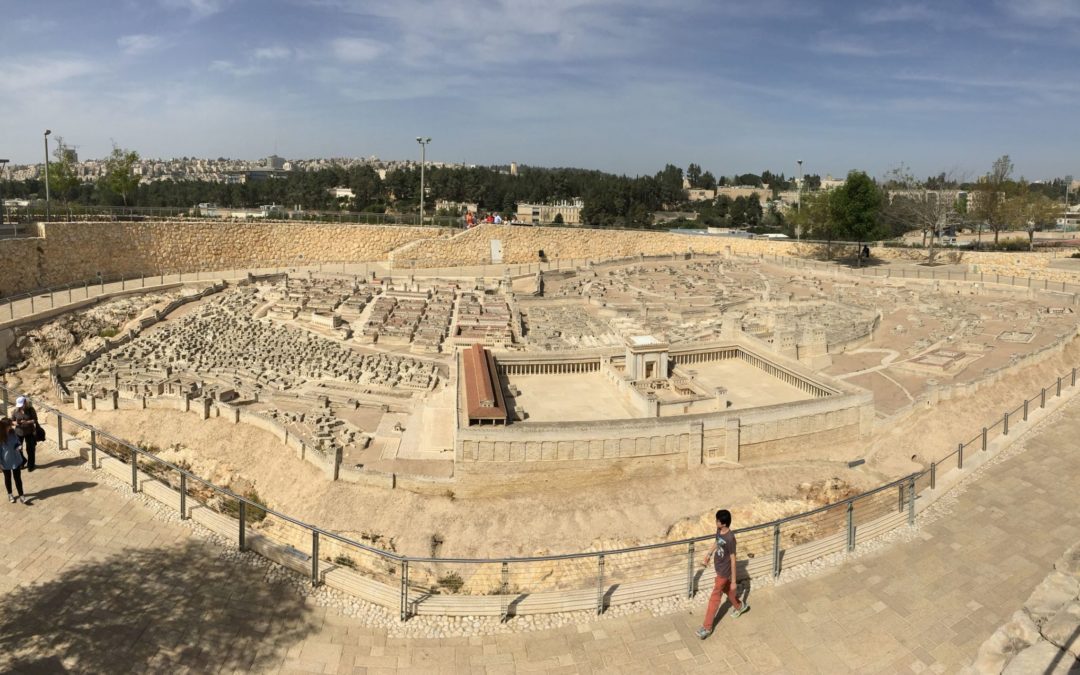“It’s even better than Legoland,†said actor Hugh Bonneville of Downton Abbey fame in the PBS show, Jesus: Countdown to Calvary. Bonneville made the comment while viewing a massive model depicting what the city of Jerusalem looked like in the first century.
My wife and I visited this huge, sprawling model—about the size of two tennis courts—at the Israel Museum in Jerusalem. And I’d have to agree with Bonneville’s assessment that the model of first-century Jerusalem is far better than Legos. And this is coming from a grown man who still loves his Legos. My office has a Lego train running through it, along with a Lego Eiffel Tower, a Lego Capitol Building, a Lego Leaning Tower of Pisa, a Lego hobbit house, a Lego…
You get my drift.
The Jerusalem model, built to a scale of 1:50, was created in the early 1960s, commissioned by Hans Kroch, owner of the Holyland Hotel. For years, the model was featured on the grounds of the hotel, but it was moved to the beautiful Israel Museum and available for viewing in July of 2006.
If you stand on the platform on the eastern side of the Jerusalem model, you look down on the Temple Mount, and its size in relation to the rest of the city will take your breath away. The Temple (the real one, not the model) was the size of 12 football stadiums, to use another sports analogy. So, it dominated the city, which was why visitors for Passover in Jesus’s time were staggered by what they saw.
King David made Jerusalem the capital of the Jewish kingdom somewhere around 1,000 B.C., and since then it has been conquered and reconquered again and again, ruled by Romans, Persians, Arabs, Fatimids, Turks, Crusaders, Egyptians, Mamelukes, and Muslims. Today, Jerusalem is sacred to three major religions—Judaism, Christianity, and Islam. And although Rome is called the “eternal city,†that name is better suited to Jerusalem because Revelation tells us about the new Jerusalem coming down from heaven.
“Then I saw ‘a new heaven and a new earth,’ for the first heaven and the first earth had passed away, and there was no longer any sea. I saw the Holy City, the new Jerusalem, coming down out of heaven from God, prepared as a bride beautifully dressed for her husband.†(Revelation 21:1-2)
The new Jerusalem is Eden restored, says Sandra Richter in her marvelous book, The Epic of Eden. New Jerusalem will have rivers of life and fruit-filled trees, and even the Tree of Life will flourish in its midst—all images of Eden. However, Richter points out that one aspect of Eden will be missing from this future city. Revelation says nothing about cherubim guarding the entrance to the new Jerusalem. Cherubim guarded the entrance to Eden when Adam and Eve were banished from the Garden, but they’re not mentioned in the new Jerusalem. God has opened wide the city gates for us. Or, as Richter puts it, “God has taken back the garden, Adam’s children are home…â€
The Jerusalem model in Israel is only a shadow of the real city. And the real city of Jerusalem is only a shadow of the new Jerusalem to come. Revelation 21:6 says the new Jerusalem will be 1,400 miles wide, 1,400 miles long, and 1,400 miles high. To get an idea how high that is, Mount Everest is only about 5.5 miles high, and yet the New Jerusalem will rise up 1,400 miles. Interestingly, this cube shape calls back to the inner sanctuary of Solomon’s Temple, which was also cube-shaped at 20 cubits long, 20 cubits wide, and 20 cubits high.
The new Jerusalem is the culmination of God’s great rescue mission, Richter says. In describing this rescue mission, she uses the metaphor of a rock climber who has fallen on a mountain.
She points out that it takes a series of steps to get a climber back to safety. Someone first needs to go down into the canyon to apply first aid. Next, the injured climber must be lifted out of the ravine by stretcher, then airlifted by helicopter, then taken to a hospital where surgery is performed. The rescue is a series of steps, and so too has been God’s rescue plan.
Our Fall in the Garden was from a great height. And in God’s spiritual rescue mission, Abraham, Moses, and David have all been steps along the way. But it is Jesus who brings ultimate healing, and He did it by dying on a cross just outside the walls of the old Jerusalem—the one laid out before me at the Israel Museum.
The Jerusalem I looked down upon is just a model, just a glimmer of the real thing. But isn’t that also true of the world outside our doors? Our world is just a hint, just a glimmer of the new Jerusalem of the future. It’s a taste of the new life in store for all who have been rescued from a great Fall.
And yes, it’s going to be a whole lot better than Legoland.
Doug Peterson



